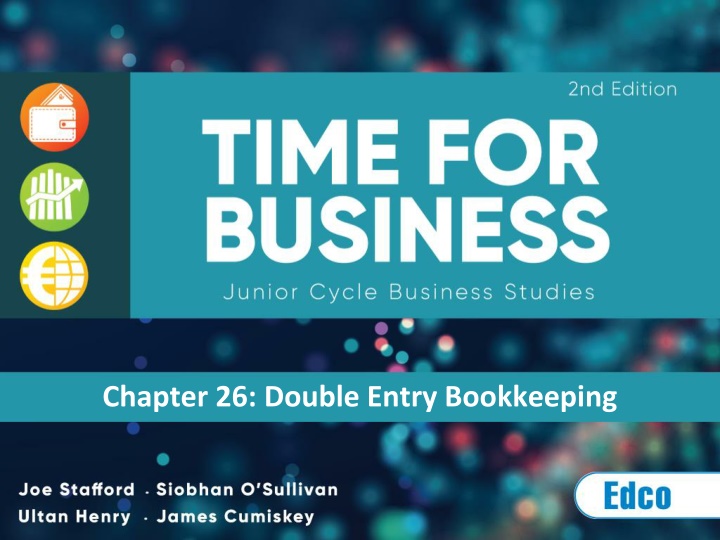
Double Entry Bookkeeping in Business
Explore the essentials of double entry bookkeeping, from recording transactions to preparing financial statements. Discover the importance of bookkeeping in evaluating an organization's financial performance. Learn about cash flow management, tax calculations, and more.
Download Presentation

Please find below an Image/Link to download the presentation.
The content on the website is provided AS IS for your information and personal use only. It may not be sold, licensed, or shared on other websites without obtaining consent from the author. If you encounter any issues during the download, it is possible that the publisher has removed the file from their server.
You are allowed to download the files provided on this website for personal or commercial use, subject to the condition that they are used lawfully. All files are the property of their respective owners.
The content on the website is provided AS IS for your information and personal use only. It may not be sold, licensed, or shared on other websites without obtaining consent from the author.
E N D
Presentation Transcript
Chapter 26 Learning intentions In this chapter you will learn to: Explain the term double entry bookkeeping Prepare an analysed cash book, post to the ledger and extract a trial balance Account for VAT on sales and purchases Appreciate the value of bookkeeping in recording and evaluating an organisation s financial performance. Textbook page reference: 308
Chapter 26 Why keep accounts? Business accounts can help with the following: Identifying and recording sources and patterns of income Identifying and recording expenditure patterns and amounts Keeping track of cash flow Calculating profitability Calculating tax returns Valuation of the business. Textbook page reference: 309
Chapter 26 The analysed cash book In bookkeeping, we use an analysed cash book (ACB) to record receipts of money coming into the business and payments of money going out of a business. Textbook page reference: 310
Chapter 26 Opening cash and bank balances The opening balance refers to the cash or bank balance at the beginning of an accounting period. In this case the balance is on the debit side. This shows that there is money in the account at the start of January. Textbook page reference: 310
Chapter 26 Ledgers Ledgers are the books that all individual accounts are recorded in. These accounts are used to bring together all transactions involving a particular business of person. They may also record all transactions involving a particular type of income or expense. Textbook page reference: 311
Chapter 26 Ledgers The general ledger (GL) is used to record all the expenses thatare involved in running a business, such as rent and electricity. Textbook page reference: 311
Chapter 26 Double entry bookkeeping Double entry bookkeeping requires that every transaction be entered twice in the accounts. This is because there is both a giving element and a receiving element involved. Textbook page reference: 311
Chapter 26 Double entry rule When dealing with cash transactions, this will require: One entry in the analysed cash book One corresponding entry in the appropriate general ledger account. A debit entry in the ACB will be posted to the credit side in the ledger. A credit entry in the ACB will be posted to the debit side in the ledger. This is because for every debit, there is a corresponding credit. Textbook page reference: 312
Chapter 26 Accounting for share capital Share capital is the money invested into a business by its owners. This money is often invested at the time the business is being set up, but extra share capital can be invested at a later date. Textbook page reference: 312
Chapter 26 Accounting for sales, purchases and VAT In accounting terms, sales refers specifically to money received when a business sells goods that are part of its normal day-to-day business activity, e.g. a shoe shop sells shoes. Textbook page reference: 313
Chapter 26 Accounting for sales, purchases and VAT The term purchases refers specifically to goods that a business buys and intends to resell as part of its normal day-to-day business activity, e.g. a shoe shop buys shoes to sell to customers. Textbook page reference: 313
Chapter 26 VAT The VAT for all sales and purchases will be recorded in a single VAT account by each business. In this case it s important to clearly identify which VAT relates to sales and which VAT relates to purchases. Textbook page reference: 314
Chapter 26 General Ledger Accounts commonly found in the general ledger include: Purchases A/C Light and Heat A/C Sales A/C VAT A/C Wages A/C Advertising A/C Share Capital A/C Carriage In A/C Carriage Out A/C Rent A/C Vehicles A/C Machinery A/C Bad Debts A/C Textbook page reference: 315
Chapter 26 Trial Balance A trial balance is simply a list of account balances. In the trial balance, we list all the balances b/d from the ledger accounts and the cash/bank balance from the analysed cash book. Textbook page reference: 316
Chapter 26 Trial Balance rule A debit balance in the ledger or ACB will appear as a debit in the trial balance. A credit balance in the ledger or ACB will appear as a credit in the trial balance. This is because the double entry has already occurred and the balances from each account are simply being listed. Textbook page reference: 316
Chapter 26 Recap and review Can you? Explain the term double entry bookkeeping Prepare an analysed cash book, post to the ledger and extract a trial balance Account for VAT on sales and purchases Appreciate the value of bookkeeping in recording and evaluating an organisation s financial performance.
Chapter 26 Credit slide Shutterstock














